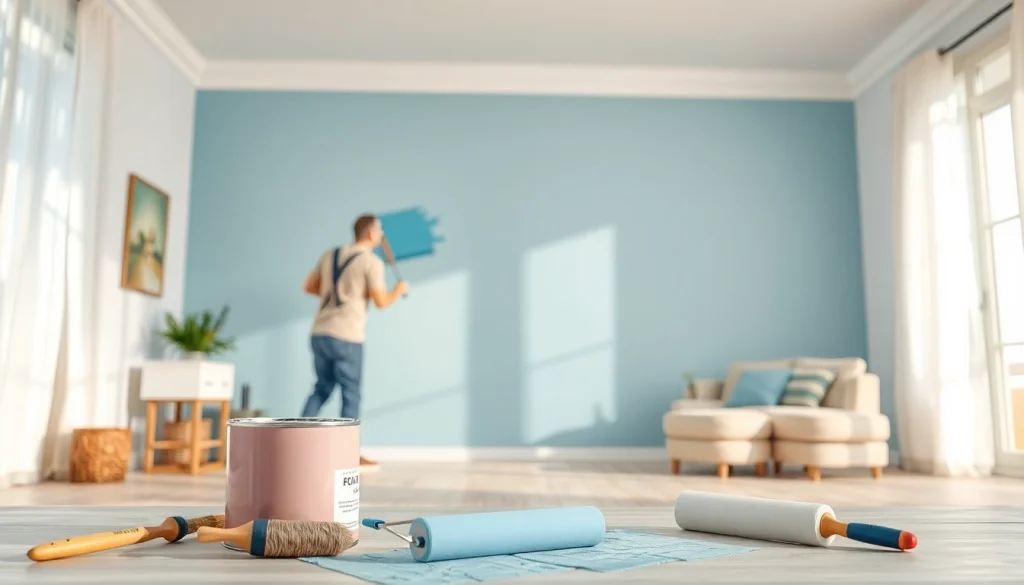Understanding the Basics of Interior Painting
What is Interior Painting?
Interior painting is the process of applying paint to the interior surfaces of a building, including walls, ceilings, doors, and trim. This essential aspect of home improvement not only enhances the aesthetic appeal of a space but also serves protective functions. A fresh coat of paint can shield surfaces from wear and tear, moisture, and even pests. It contributes significantly to a home’s overall ambiance and can transform the look and feel of a room. Whether you are rejuvenating a single room or embarking on a full-scale interior overhaul, understanding the nuances of interior painting is vital. For those looking for comprehensive guidance, our site offers a range of resources related to interior painting.
Benefits of Interior Painting
The benefits of interior painting extend beyond mere aesthetics. Here are several key advantages:
- Enhanced Aesthetics: A well-executed paint job can dramatically change the perception of a space. Different colors and finishes create unique atmospheres, inviting warmth, serenity, or sophistication.
- Increased Property Value: Investing in high-quality interior painting can increase your home’s resale value. Potential buyers often have a positive impression of homes that are well-maintained and visually appealing.
- Protective Coating: Paint serves as a barrier against moisture, dirt, and pollutants. It helps protect surfaces from deterioration, thereby prolonging the life of your walls and furnishings.
- Health Benefits: Modern paints often use low or no VOC (volatile organic compounds), making indoor air quality healthier. This is particularly beneficial for individuals with allergies or respiratory issues.
- Customization: Interior painting provides homeowners with the freedom to reflect personal style through color choices, patterns, and finishing techniques.
Materials and Tools Needed for Interior Painting
To achieve a flawless finish in interior painting, it’s essential to have the right materials and tools at your disposal. Here’s a thorough list:
- Paint: Choose the right type of paint based on the space. Options include latex (water-based) and oil-based paints, each suitable for different surfaces and desired finishes.
- Primer: Applying a primer before the paint helps even out the surface and ensures better adhesion of the paint.
- Brushes and Rollers: A variety of brush sizes (angled and flat) and roller covers are needed for different areas (i.e., textured walls, flat surfaces).
- Painter’s Tape: This helps protect edges and create clean lines during the painting process.
- Ladder and Drop Cloths: A ladder is necessary for reaching high areas, while drop cloths protect furniture and floors from paint splatters.
- Paint Trays: These allow for easy loading of paint onto brushes and rollers, facilitating a more efficient painting process.
Choosing the Right Colors for Your Interior Painting Project
Trends in Color for Interior Spaces
Color trends in interior design evolve regularly, influenced by cultural shifts, technological advancements, and design innovations. As of 2023, some emerging trends include:
- Earthy Tones: Shades of terracotta, olive green, and muted yellows are gaining popularity, evoking a sense of calm and connection to nature.
- Bold and Statement Colors: Rich blues, deep greens, and even black are being used to create dramatic focal points in living spaces and accent walls.
- Pastels Reimagined: Soft pastel hues are being combined with bolder accents to create energetic yet balanced rooms.
- Neutral and Monochrome Palettes: Soft neutrals paired with various textures instill quiet elegance in modern homes.
How to Select Colors Based on Room Function
Every room serves a unique purpose, and color selection should correspond to the intended function:
- Living Rooms: Opt for warm colors that encourage socialization and comfort, such as soft browns, creams, or warm grays.
- Bedrooms: Soft blues, greens, and lavenders create a tranquil atmosphere conducive to relaxation and sleep.
- Kitchens: Bright, cheerful colors like yellows or light greens can stimulate appetite and foster a sense of energy.
- Bathrooms: Light, airy colors like soft blues or whites enhance cleanliness and calmness.
Color Psychology in Interior Painting
Understanding color psychology can significantly impact how a space feels and functions. Here are some commonly recognized color associations:
- Blue: Calming and serene, ideal for spaces meant for relaxation.
- Red: Energetic and stimulating, often used in social areas to encourage communication.
- Yellow: Cheerful and bright, perfect for spaces needing an energy boost.
- Green: Refreshing and restful, often associated with nature — perfect for any space desiring tranquility.
- Gray: Versatile and modern, providing a sophisticated neutral backdrop that can be paired with various accent colors.
Preparing Your Space for Interior Painting
Steps for Properly Cleaning and Repairing Walls
Preparation is crucial to ensure a professional finish when painting. Here’s how to properly prepare your walls:
- Remove Furniture: Clear the room of furniture or cover it with drop cloths to protect against dust and paint.
- Clean Walls: Wipe down walls with a damp cloth to remove dust, grease, and grime that can prevent paint from adhering properly.
- Repair Damages: Fill holes, cracks, or imperfections with spackle or wall filler and sand them flat for a smooth surface.
- Wash Surfaces: For kitchens and bathrooms, washing walls with a mild detergent can help remove residues that might interfere with paint adhesion.
Protecting Furniture and Floors
To safeguard your belongings during the painting process, take the following precautions:
- Use Drop Cloths: Lay drop cloths or plastic sheets on the floor and cover larger furniture pieces with linen or plastic sheets.
- Remove Accessories: Take down curtains, wall hangings, and smaller items that could get damaged or dirty during the painting process.
- Seal Areas: Use painter’s tape around edges of trim and floors to create clean lines and prevent paint spills.
Choosing the Right Type of Paint Finish
The choice of paint finish can greatly influence the final look and feel of a room. Here’s a breakdown of common types of finishes:
- Matte Finish: Ideal for hiding wall imperfections, but less durable and hard to clean.
- Satin Finish: Provides a slight sheen, is easier to clean, and is suitable for moderate-traffic areas.
- Eggshell Finish: Offers a balance between matte and satin, commonly used for walls in living spaces.
- Gloss Finish: Highly reflective, extremely durable — great for trims and areas prone to moisture, like kitchens and bathrooms.
Best Practices for a Professional Interior Painting Finish
Techniques for Applying Paint Evenly
How you apply paint can determine whether your finish is flawless or flawed. Here are expert techniques:
- Use the Right Tools: Invest in quality brushes and rollers to achieve even coverage.
- Apply in Thin Coats: Two to three thin coats are better than one thick coat, allowing for even drying and less likelihood of drips.
- Keep a Wet Edge: Work in sections to maintain a wet edge, which helps avoid lap marks.
Using Painter’s Tape Effectively
Painter’s tape is essential for achieving clean lines and protecting surfaces. Here’s how to use it effectively:
- Clean Surface: Ensure the surface is clean and dry before applying the tape for better adhesion.
- Press Firmly: Run a finger along the edge of the tape to seal it against the surface, preventing paint bleed.
- Remove Tape While Wet: Remove the tape while the paint is still wet for the best results, pulling it away at a 45-degree angle.
Common Mistakes to Avoid in Interior Painting
Even seasoned painters can make mistakes. Here are some common pitfalls and how to avoid them:
- Skipping Primer: Not using a primer can lead to uneven paint absorption and a less vibrant finish. Always prime when necessary.
- Poor Color Selection: Test colors in the actual room lighting before making a final decision. Lighting can significantly affect how a color appears.
- Ignoring Ventilation: Ensure proper ventilation during painting to help the paint dry evenly and reduce fumes. Open windows and doors where permitted.
Hiring Professional Help vs. DIY for Interior Painting
When to Hire a Professional Painter
Hiring a professional can save you time and ensure high-quality results. Consider the following when deciding:
- Extensive Surface Preparation: If walls require significant repair or prep work, a professional’s expertise may be beneficial.
- High Ceilings or Difficult Access: Professionals have the right tools and skills to safely paint hard-to-reach areas.
- Complex Techniques: For techniques like stenciling or intricate color blending, hiring skilled painters can elevate the quality of the work.
Cost Comparison: DIY vs. Professional Services
The cost of interior painting can vary widely based on DIY efforts versus hiring a professional. Here’s a breakdown:
- DIY Costs: Materials can range from $150 to $800 depending on paint quality and quantity for a single room, excluding tools.
- Professional Costs: Hiring a professional typically ranges from $300 to $2,500 for an average-sized room, taking into account labor and materials.
- Value of Time: If you lead a busy lifestyle and lack the time or skill, hiring a professional may be worth the cost.
Finding the Right Painter for Your Project
Choosing the right professional can significantly impact your painting project’s success. Consider these tips:
- Check Reviews: Look for online reviews and testimonials from previous clients to gauge the quality of the painter’s work.
- Ask for Quotes: Obtain detailed quotes from multiple painters, ensuring they break down labor and material costs.
- Verify License and Insurance: Ensure that the painter is licensed and insured to protect yourself from liabilities during the project.





